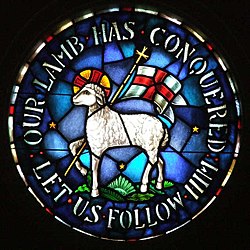
Back Morawiese kerk Afrikaans الكنيسة المورافية Arabic الكنيسه المورافيه ARZ Moravští bratři Czech Морави чиркĕвĕ CV Yr Eglwys Forafaidd Welsh Herrnhutiske Brødremenighed Danish Herrnhuter Brüdergemeine German Moraviaj fratoj Esperanto Hermandad de Moravia Spanish
| Unity of the Brethren | |
|---|---|
| Latin: Unitas Fratrum | |
 A stained glass emblem of Agnus Dei at Trinity Moravian Church in Winston-Salem, North Carolina | |
| Classification | Proto-Protestant |
| Orientation | Hussite (Bohemian) with Pietist Lutheran influences |
| Associations | Christian Churches Together |
| Founder | Followers of Jan Hus and Petr Chelčický; later renewed by Nicolaus Ludwig Zinzendorf, Christian David and David Nitschmann |
| Origin | 1457 / 1722 Bohemia / Herrnhut, Saxony |
| Congregations | 1,000+[1] |
| Number of followers | 1,112,120 (2016)[2] |
| Official website | unitasfratrum |
| Part of a series on |
| Christianity |
|---|
 |
The Moravian Church, or the Moravian Brethren (Czech: Moravská církev or Moravští bratři), formally the Unitas Fratrum (Latin: "Unity of the Brethren"),[3][4][5] is one of the oldest Protestant denominations in Christianity, dating back to the Bohemian Reformation of the 15th century and the Unity of the Brethren (Czech: Jednota bratrská) founded in the Kingdom of Bohemia, sixty years before Martin Luther's Reformation.
The church's heritage can be traced to 1457 and the Lands of the Bohemian Crown, which included Bohemia, Moravia, Silesia, and previously the Hussite movement against several practices and doctrines of the Catholic Church. Its name is derived from exiles who fled from Moravia to Saxony in 1722 to escape the Counter-Reformation, establishing the Christian community of Herrnhut. Hence, it is also known in German as the [Herrnhuter] Brüdergemeine [sic][6] ("Unity of Brethren [of Herrnhut]").[7]
The modern Unitas Fratrum has about one million members worldwide,[1] continuing their tradition of missionary work, such as in the Americas and Africa, which is reflected in their broad global distribution.[8] Moravians continue many of the same practices established in the 18th century, including placing a high value on a personal conversion to Christ, called the New Birth, and piety, good works, evangelism, including the establishment of missions, Christian pacifism, ecumenism, and music.[8][9]
The Moravian Church's emblem is the Lamb of God (Agnus Dei) with the flag of victory, surrounded by the Latin inscription "Vicit agnus noster, eum sequamur" ('Our Lamb has conquered; let us follow Him').
Apart from the Moravian Church, the more conservative Unity of the Brethren, based in Texas, as well as the Czechoslovak Hussite Church, based in the Czech Republic and Slovakia, are denominations in the same Hussite-Moravian theological tradition.[10]
- ^ a b Cite error: The named reference
statswas invoked but never defined (see the help page). - ^ Cite error: The named reference
Membershipwas invoked but never defined (see the help page). - ^ "Moravian History". Moravian Church of the British Province. Archived from the original on 23 February 2016. Retrieved 11 March 2017.
- ^ "Unitas Fratrum". Unitasfratrum.org. Retrieved 12 March 2017.
Unitas Fratrum, the Worldwide Moravian Church consists of Unity Provinces, Mission Provinces, Mission Areas and certain areas of work which are the responsibility of the Moravian Unity as a whole.
- ^ "The Unity of the Brethren". Christianity Today. 1987. Retrieved 11 March 2017.
- ^ "Herzlich willkommen" [Warm welcome]. Ebu.de (in German). Evangelische Brüder-Unität - Herrnhuter Brüdergemeine. Archived from the original on 11 April 2020. Retrieved 12 March 2017.
- ^ "Moravian church | Protestant denomination". Encyclopedia Britannica. Retrieved 2021-09-15.
- ^ a b Atwood, Craig D. (2012) [2011]. "Moravian Church". The Encyclopedia of Christian Civilization. Chichester, West Sussex: Wiley-Blackwell. doi:10.1002/9780470670606.wbecc0935. ISBN 9781405157629.
The Moravian Church's impact on Christianity and world culture is disproportionate to its size (about 750,000 members in 2007). In the 18th century, the church engaged in social experiments that challenged patriarchy, racism, and economic exploitation, and pioneered culturally sensitive missions to indigenous peoples in the Americas and Africa. It is also famous for its contributions to Protestant hymnody and liturgy, and its Losungen or daily watchwords remain one of the most popular resources for personal devotions in Germany. The most famous reader of the Losungen, was the theologian Dietrich Bonhoeffer, whose Finkelwalde Seminary was modeled in part on the example of the Moravians.
- ^ Cite error: The named reference
Atwood1991was invoked but never defined (see the help page). - ^ Kurian, George Thomas; Day, Sarah Claudine (14 March 2017). The Essential Handbook of Denominations and Ministries. Baker Books. ISBN 978-1-4934-0640-1.